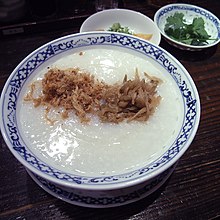Rice congee
Reis-Congee ( Tamil kanji , IPA [ ˈkɒndʒiː ]; Thai : Chok, also: Joke - โจ๊ก ; viet . : cháo ; Tagalog : Lugaw; Chinese 粥 , Pinyin zhōu , Jyutping zuk 1 , 稀飯 / 稀饭 , xīfàn , Jyutping hei 1 faan 6 ) is a congee that in Asia , especially China , is eaten primarily for breakfast .
To prepare it, one part of rice is boiled with ten to twelve parts of water or broth and cooked for about four hours over low heat until the rice disintegrates and a creamy, almost tasteless porridge has formed. Because of the long preparation time, rice congee is usually cooked in advance for several days.
Rice congee is served pure or supplemented with other ingredients such as tsa tsai , bamboo shoots , fish , meat , millennial eggs , peanuts , shallots and soy sauce . As a dessert, rice congee is mixed with red beans and sugar .
The Japanese variant, Okayu ( Japanese お 粥 御 粥 , Kana お か ゆ ), is firmer, with only six parts of water and with half an hour to an hour, it is cooked much shorter. In Japan ( Okayu ) and China ( zhou ), rice porridge is a common health food. The Nanakusagayu ( 七 草 粥 , Kana な な く さ が ゆ ), Okayu with seven herbs, is traditionally eaten on January 7th to ward off evil for the New Year and to wish good luck and a long life.
In Chinese medicine , rice congee is used in nutritional therapy with certain additional ingredients.
